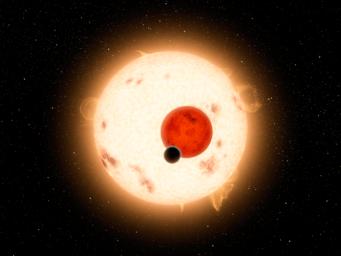The 245 light-years distant Kepler-16b is the first binary star planet found with the radial velocity method.
For a long time it was questionable whether there can be planets around binary stars at all.
The center of this triple system is Kepler-16A, a K-type star orbited by Kepler-16B, an M-type star. Neither star can be seen with the naked eye from Earth.
The gas planet Kepler-16b orbits its two host stars at a large distance and is therefore outside the habitable zone, so it will not contain liquid water and will be very cold.
How planets form around binary stars is not yet fully understood. Probably they form much further outside and later migrate inward by gravitational interaction.
To be able to observe the constellation of Kepler-16A and its two companions will hopefully soon provide further knowledge about the formation of these systems.

